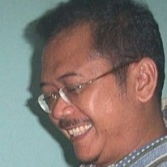
Agus Harjoko
Work place: Department of Computer Science and Electronics, Faculty of Mathematics and Natural Sciences Universitas Gadjah Mada, Yogyakarta, 55281, Indonesia
E-mail: aharjoko@ugm.ac.id
Website:
Research Interests: Computer systems and computational processes, Computer Vision, Computer Graphics and Visualization, Image Processing, Medical Image Computing
Biography
Agus Harjoko. He had his undergraduate degree (Drs) in Electronics and Instrumentation, FMIPA, Universitas Gadjah Mada, Yogyakarta, Indonesia in 1986, and Master (MSc) in Computer Science, University of New Brunswick, Canada, in 1990. He had his Doctor (PhD) from Faculty of Computer Science, University of New Brunswick, Canada, in 1996.
Dr. Harjoko’s research area of interests are digital image and video processing, machine vision, and pattern recognition.
Author Articles
Multi-Character Fighting Simulation
By Sukoco Retantyo Wardoyo Agus Harjoko Mochamad Hariadi
DOI: https://doi.org/10.5815/ijisa.2018.08.01, Pub. Date: 8 Aug. 2018
In the development of and research into multi-character fighting computer games, Non-Player Characters (NPCs) frequently seem less intelligent owing to them having a single focus. As such, multi-character fighting becomes one-on-one fighting; one character will encounter another character only once the previous opponent is defeated. This study develops a new model in multi-character fighting, in which each NPC can simultaneously fight against many characters. Following this model, each character becomes an agent that makes his own decisions. The first advantage of this model is the integration of multi-character behaviors in fights. Each character can seek out enemies/opponents, select one target opponent, avoid obstacles, approach the target opponent, change the target opponent, and then defeat the opponent or be defeated by the opponent; in other words, each character can thus fight against many opponents. All of the behaviors in the fight take place automatically. The second advantage of this model is that each character does not only focus on the opponent being targeted, but also on the other opponents surrounding him. Each character can move from one opponent to another, even when the target opponent is not yet defeated. The third advantage of this model is that each character can move to another fight cluster, thus ensuring that fights seem more dynamic. This research has experimented with the model using a 3D application that can run on personal computers or smart phones.
[...] Read more.Batik Classification with Artificial Neural Network Based on Texture-Shape Feature of Main Ornament
By Anita Ahmad Kasim Retantyo Wardoyo Agus Harjoko
DOI: https://doi.org/10.5815/ijisa.2017.06.06, Pub. Date: 8 Jun. 2017
Batik is a textile with motifs of Indonesian culture which has been recognized by UNESCO as world cultural heritage. Batik has many motifs which are classified in various classes of batik. This study aims to combine the features of texture and the feature of shapes’ ornament in batik to classify images using artificial neural networks. The value of texture features of images in batik is extracted using a gray level co-occurrence matrices (GLCM) which include Angular Second Moment (ASM) / energy), contrast, correlation, and inverse different moment (IDM). The value of shape features is extracted using a binary morphological operation which includes compactness, eccentricity, rectangularity and solidity. At this phase of the training and testing, we compare the value of a classification accuracy of neural networks in each class in batik with their texture features, their shape, and the combination of texture and shape features. From the three features used in the classification of batik image with artificial neural networks, it was obtained that shape feature has the lowest accuracy rate of 80.95% and the combination of texture and shape features produces a greater value of accuracy by 90.48%. The results obtained in this study indicate that there is an increase in accuracy of batik image classification using the artificial neural network with the combination of texture and shape features in batik image.
[...] Read more.Other Articles
Subscribe to receive issue release notifications and newsletters from MECS Press journals